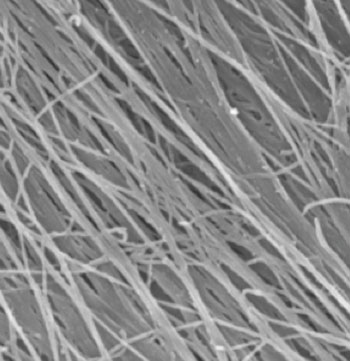Highly Aligned Nanofibers Developed for Tissue Engineering Applications
By LabMedica International staff writers
Posted on 10 Mar 2014
A team of biomedical engineers has constructed a uniform highly aligned nanoscale fibrous scaffolding from extracellular matrix (ECM) naturally deposited by fibroblasts to be used for potential tissue engineering applications.Posted on 10 Mar 2014
When placed in contact with ECM obtained from epithelial cells or fibroblasts, cells attach quickly, exhibit high plating and cloning efficiencies, proliferate rapidly, reach a high saturation density, exhibit lower requirements for serum and added growth factors, respond better to physiologically occurring hormones, express differentiated functions, have longer life span, undergo flattening and morphological changes, and have better plating consistency. Such cells adopt growth characteristics, morphological appearance, and biological responses that are not expressed when the same cells are maintained on artificial substrata (plastic, glass), even if coated with isolated constituents of ECM such as purified collagen or glycoproteins.

Image: Highly aligned nanofibers created by fibroblasts form biological scaffolding that could prove an ideal foundation for engineered tissues. Stem cells placed on the scaffolding thrived, and it had the added advantage of provoking a very low immune response (Photo courtesy of Dr. Feng Zhao, Michigan Technological University).
Investigators at Michigan Technological University (Houghton, USA) used synthetic nanogratings (130 nanometers in depth) to direct the growth of human dermal fibroblasts for up to eight weeks, resulting in a uniform 70 micrometer-thick fibroblast cell sheet with highly aligned cells and ECM nanofibers. A natural ECM scaffolding with uniformly aligned nanofibers about 78 nanometers in diameter was generated after removing the cellular components from the fibroblast sheet.
In a report published in the January 29, 2014, online edition of the journal Advanced Functional Materials the investigators demonstrated the excellent capacity of the ECM-scaffolding in directing and supporting alignment and proliferation of reseeded human mesenchymal stem cells (hMSCs) along the underlying fibers. Furthermore, the aligned ECM scaffolding induced a significantly lower immune response compared to its unaligned counterpart, as detected by proinflammatory cytokines secreted from macrophages.
“The cells did the work,” said senior author Dr. Feng Zhao, assistant professor of biomedical engineering at Michigan Technological University. “The material they made is quite uniform, and of course it is completely biological. We think this has great potential. I think we could use this to engineer softer tissues, like skin, blood vessels, and muscle.”
Related Links:
Michigan Technological University














